Chapter I
The town of Yekaterinoslav was exclusively the creation of Prince G. A. Potemkin. Prince Potemkin was a well-known favourite of Catherine II. Being at the height of his fame and power he passed to the Empress a scheme which was daring up to impudence (considered so in those days). This plan was for chasing the Turks out of Europe, which all the European monarchs had failed to do during their crusades in the Middle Ages. Potemkin wanted to open the way to the East, to Asia, like Peter the Great had opened the window to Europe. Carried away by his project, Catherine II, considering Prince Potemkin a genius, decided to place one of her grandsons on the extinct throne of Byzantine Emperors. She had her grandson named Konstantin which reminded of Emperor Constantine Paleolog who had heroically defended the capital Constantinople in 1453 against the innumerable Turkish hordes. Yelena Kordanova, a Greek woman,
was appointed to the infant Grand Prince Konstantin as a breast-feeding nurse.
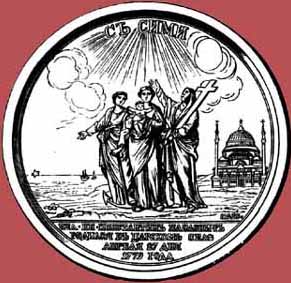
|
The medal from the infant Grand Prince Konstantin
|
But the wealthy and bewitching East with its gold, porphyry, byssuses, myrtles, palms, sycamores was only to be seized in the future, it was only in the prospects. First of all, it was necessary to capture the Turkish fortresses standing on the Lower Dnieper on both banks and blocking the way for the Russians to the Black Sea. They were-Ochakov, KyzykermenTT&slankermen, Muberekkermen, Kinburn. It was there that the Russian troops were sent firstly. Together with the Russian forces during four years (1771-1774) in operation were the troops from Zaporozhye. The action of the Zaporozhians can be seen from the fact that in 1771 the Zaporozhian Colonel Afa-nasy Kolpak and his Esaul (Cossack captain.-Transl.) Yevsta-fy Kobelyak "were mercifully granted" golden medals on the ribbon of St. Andrew to be worn on their necks. Ataman (Cossack chief.- Transl.) P. I. Kalnishevsky at that time was successfully engaged in action near the Bug River.
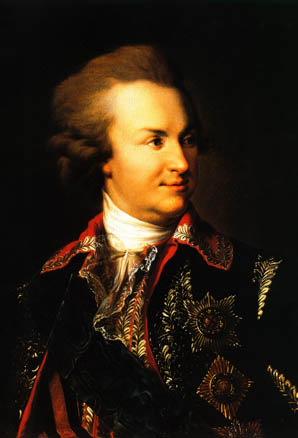
|
The Prince G. A. Potemkin.
|
The herioc deeds of the Zaporozhian Cossacks won high appraisal from Empress Catherine II, who sent a charter to the Zaporozhian Sech to Ataman Kalnishevsky in which the tsarina wrote: "Having received your report dated November 5 about your return to the Sech with your forces, I couldn't remain silent without wishing you and all the Zaporozhian troops an imperial goodwill for the aid rendered us in the campaign that has just ended in camouflaging the town of Ochakov and the excellent zeal and diligence in performing it.We undoubtedly hope that praiseworthy and loyal Zaporozhian troops in the future shall not abandon service and shall display just as great zeal, courage, and bravery as they are famous for all over the world up till now. And we shall demonstrate them our reverence. December 2, 1771."
In 1772 the Zaporozhian forces keeping on displaying their diligence and courage took an active part together with the Russian army against Tatars and Turks. The same Colonel Afanasy Kolpak with other Cossack colonels and seniors distinguished themselves in action.
In the same year of 1772 the Zaporozhians saw Prince Potemkin for the first time. Then the Prince was still major-general serving in the ranks of the 1st Field Army under the command of Count Rumyantsev and was accompanied by several Zaporozhian Cossacks and two seniors. One of them was Yakov Tronevich for whom he applied and obtained a gold medal.
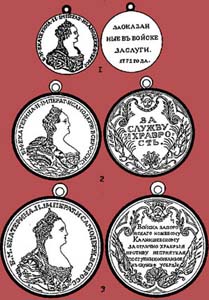
|
The golden medals from Zaporozhian Sech.
|
The courage of the Zaporozhian Cossacks, their valour and joviality impressed Potemkin so greatly that he decided to join the Kushchevsky Kuren (unit of the Cossack troops.- Transl.). As a result he addressed a letter to the Ataman of the Zaporozhian troops P. I. Kalnishevsky. Calling him gracious father and assuring him of his great love for the whole Zaporozhian forces, he begged to be enlisted in the ranks of the Cossacks. "Don't refuse, dear Sir, to answer my request. Always ready to serve you, my Gracious Father, Grigory Potemkin. April 15, 1772."
In reply P. I. Kalnishevsky wrote: "We had the honour of receiving the most respectful scripture from Your Excellency on the same day of a happy event which had caught us ready to follow your request with pleasure. In response to it we are forwarding to you an open letter which is in fact a testimonial certificate of your being enlisted into the Cossack ranks, into the Kushchevsky Kuren of the Zaporozhian troops. By congratulating you with this event we implore Your Excellency not to deprive the Zaporozhian forces of your favour. May 25, 1772."
Prince Potemkin answered: "I received your testimonial via Vasily Chernyavsky. Earnestly thanking you in return I beg you to receive my present which is the first token of my diligence until I get a chance to prove what I am. Your obedient servant, dear Sir. Yours Grigory Potemkin."
Enjoying their usual tradition of giving nicknames to all persons joining the Zaporozhian Sech, the Cossacks nicknamed Prince Potemkin Nechesa (dishevelled) for the sight of his wig he was wearing according to the fashion in those days. Not understanding or maybe pretending to not understand the Cossacks called him Gritsko Nechesa.
Continuing their military action against the Turks, in 1773 the Zaporozhian troops were stationed near Ochakov and Kinburn under the command of the same courageous and brave Colonel Afanasy Kolpak.
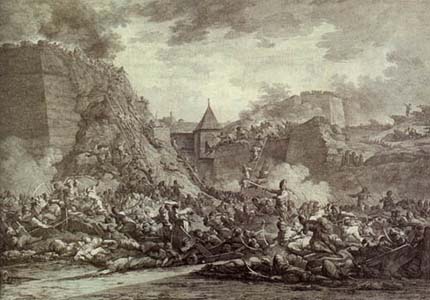
|
Near Ochakov of 1774.
|
The following year of 1774 found Colonel A. Kolpak at first still near Ochakov, then he was transferred to Perekop, to Kolonchak; everywhere he fought with great success routing and defeating the Turks. In the same year of 1774 the Zaporozhian forces got the pleasant news that by Imperial order Prince Potemkin was appointed Governor-General of the Novorossiisk Gubemia (province) and Commander-in-Chief of the forces situated there. The Zaporozhians rejoiced at such a high assignment for their comrade-in-arms and expected all the best from him.
In the same 1774 another piece of news came: from the headquarters of Count Rumyantsev in the night between the 21st and 22nd of July there had come a messenger to the village of Kuchuk-Kainardji with the happy news that the two rulers of Russia and Turkey had concluded a treaty of eternal peace between the two empires on July 10, 1774.
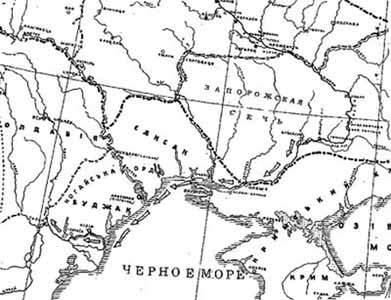
|
The company of 1774.
|
Then Prince V. M. Dolgoruky, who was in military action against the Crimean khan, when sending his forces back to their homeland and parting with the Cossacks addressed Ataman P. I. Kalnishevsky with such an order: "After the conclusion of the eternal peace treaty with the Ottoman Porte I express my merited gratitude for the courageous aspiration against the enemy in the war that is over. After receiving this order I recommend the Cossacks to return immediately to their settlements and the forces to be dismissed home, as well as the infantry on the Lower Dnieper stationed on boats."
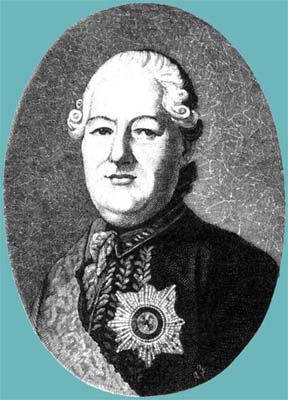
|
The prince V. M Dolgoruky
|
In his letter to the Ataman Prince V. M Dolgoruky wrote about Colonel Afanasy Fyodorovich Kolpak in particular: "Sending Colonel Kolpak to the forces I consider that I should render the senior his due for his most zealous and diligent service to Her Imperial Majesty. And, as you, Sir Ataman, seniors and the troops know about his courageous deeds so it remains for me to end by marking him with worthy praise for fine behaviour, valour and zealous service. From Perekop. August 24, 1774."
Thus the hard and long Russian-Turkish war was over. The Zaporozhian Cossacks who had taken the most ardent and most active part in the war had full right to expect favour from the tsarina and attention from His Highness Prince Potemkin, their companion-in-arms in the Kushchevsky Kuren. But, however, they were bitterly and cruelly deceived in their expectations! After the end of the war of Russia against Turkey they were needed no more, neither by the Empress nor by Potemkin. That is why when hardly a year had passed the Cossacks were treated in quite a different manner -as robbers. They became "robbers, ravagers, murderers, bandits, disobeyers of tsarist decrees". "At first, they led an idle and carefree life, later they took up farming for themselves and by this they ruined the very basis of dependence upon our throne and planned to form a quite independent region in the country under their own control."
What were the reasons for such a sudden and unexpected change of opinion about the Zaporozhians by the Empress? The reasons are evident in the tsarina's very order. First of all, it is necessary to say that Zaporozhye was a kind of a state in a state. A state without a tsar, without boyars (landlords), without scribes, a state prohibiting serfdom yoke. The Cossacks called their lands unrestricted and about themselves they said: "We are joyful because there is no roof over us," that is we always live happily for we have no pressure from above. In the future under favourable conditions the free Zaporozhian Sech might become a nucleus of such a free people's government which had formerly existed in the towns of Novgorod and Pskov against which Moscow had had a long struggle. And could Catherine bear such a people's government in Russia, that
Empress who had created the so-called superproduction of nobility and their serfdom which made the people call her "landowners' tsarina" most often? For such a tsarina Zaporozhye had become an eyesore.
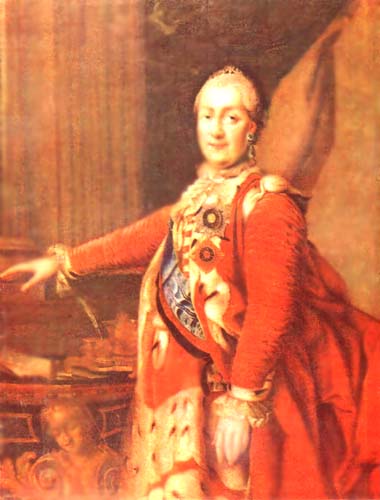
|
A.P.Antropov.
The Empress Catherine II.
|
That was the first reason why Catherine II found it necessary to destroy the Zaporozhian Sech.
There was another reason as well.
Having struggled many years, many centuries against the Tatars, the Turks, the Poles, for a long time the Cossacks had been mainly satisfied "with military plundering" and "paid little attention to their own land". Now after the conclusion of the "everlasting peace treaty" with Turkey in 1774 the Zaporozhian forces had to pass over to their own provision. And for that they had to reconstruct the military system little by little and turn to farming. This was immediately realized by the "beneficent Fathers" of the Cossack troops headed by the wise and far-sighted Ataman Petro Ivanovich Kalnishevsky. Yielding to the inspiration of the rational seniors the Cossacks began to change their swords into ploughs more and more, and they more and more diligently "turned into farmers". That also alarmed Catherine II.
Besides that, the very Zaporozhian region with its inexhaustible wealth, its Dnieper River, Bug and others full of fish, its vast steppes and luxuriant pastures, all this could not help attracting Russian noblemen-serfowners: For a long time they had "sighed" for that territory and by "sighing" had done their best to persuade the tsarina to liquidate the Zaporozhian Sech and to grant the land to the nobility.
The reason for destroying the Zaporozhian Sech was endless complaints addressed to Catherine II against the Zaporozhians from foreigners whose parents had once been invited to Russia before, during the reign ofYelizaveta Petrovna (Elizabeth), and whose settlements had spread in the western and eastern borderlands of the Zaporozhian area; in the west they founded Yelizavetgrad and in the east Lugansk. They were Bulgarians, Roumanians, Hungarians, Serbians known under the name of New Serbians and Slav-Serbians. They pressed upon the Zaporozhians from both sides like a huge snake squeezing a human being with its encircling rings.
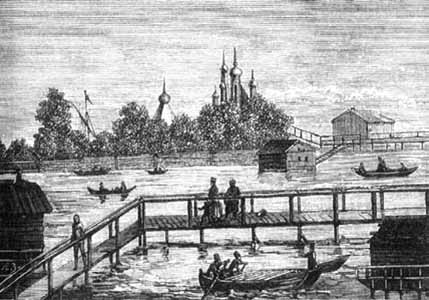
|
The Zaporozhian Sech in XVIIIth.
|
Inaccurate demarcation of the borders of the land between the newcomers and the Zaporozhians often caused arguments turning into fights and even murders from both sides. In guarding their rights and freedom from the capturers the Cossacks sent complaints to the capital. But in vain, how these people, low in rank, could struggle against such nobles as the Khor-vaty, the Miloradoviches, the Depreradoviches, the Sheviches and others. Having come from abroad to Russia they soon were granted both land and high titles and had easy admittance up to the very throne of the tsars. In the capital the Zaporozhians were considered as wild people, robbers, murderers, destined to political penalty.
So on June 4, 1775 this brought about the abolishment of the Zaporozhian Sech.
Oh, from the town of Elizabeth
Blueish-grey eagles flew out.
And in Moscow in the conference hall
Oh, are the mister senators,
Highest generals, colonels.
They thought and guessed:
"Oh, how should we, how should we
Chase the Cossacks from the steppe
And capture all the lands of the Zaporozhians?"
The lords took away their lands
And began to divide them.
The Cossacks got on their black horses
And escaped to the Turks.
After the fall of the Sech the establishment of the Novorossiisk territory was laid upon Governor-General Prince Potemkin.
What did he begin from?
First of all, he began with distributing the land to the newcomers, only to landowners... "Part my garments among them, and cast lots upon my vesture," said the Zaporozhians repeating the sexton and left their own homes in floods of bitter tears.
The former Zaporozhye was no longer called Zaporozhye, but the Slavyansk and Kherson provinces. "The place where the Zaporozhian Sech had been situated orally and in written form was renamed Pokrovsk. The former kurens with all kinds of outhouses from now on are to be called state barracks for billeting, therefore all the shops at the market attached to them, taverns with ice-houses and cellars, no matter how many there are, now are not to belong to the kuren but to the state to be on hire. That's why all the profit from them pertains to the official treasury from this time onwards until further consideration according to the basis today."
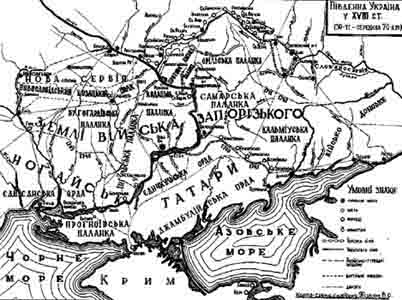
|
The Zaporozhian Sech.
|
In view of the fact that the lands of the Zaporozhians were now passed over to the landowners, it was necessary to have near at hand an exact map of the whole territory of the former Zaporozhye. So on June 18, 1775 Prince Potemkin gave orders to Lieutenant-General Pyotr Tekely to immediately command V. M. Muromtsev, Governor-General of Novorossiisk, "to make an exact map of the Zaporozhian Sech and their former property with the help of qualified officers, in case of a lack of such officers it is ordered to have them transferred from the troops of Nefedyev."
After receiving such a command from Prince Potemkin Major-General V. M. Muromtsev entrusted the Division Quartermaster Fyodorov to sail down the right bank of the Dnieper, from the site of the former Zaporozhian Sech, while engaged in doing that he was to take notice and put down whether there were any forests and where on the islands of the Dnieper, notice what rivulets fell into the Dnieper and whether there were any bushes or reeds in the woods. Lieutenant-Colonel Misyurev was to sail down along the left bank of the Dnieper and do the same.
Whether such a map of the Zaporozhian Sech and all its possessions in the Zaporozhye region had been drawn or not it is unknown. Known is only what had been done during that period in relation to this problem by Lieutenant-Colonel Pyotr Norov. Yet during the existence of the Zaporozhian Sech there had been a so-called Russian Novosechensky retrenchment in which there was a garrison consisting of two companies. When instead of the Sech founded was the town of Pokrovsk, by presentation of Major-General V. M. Muromtsev its commandant was temporarily appointed Pyotr Norov, Lieutenant-Colonel of the Ingermanland Regiment. In 1775 he collected "exact information about the large settlements and winter-lodges in the former freelands of the Zaporozhian Cossacks and nominated special inspectors in the settlements." What was the information like still remains unknown too.
Unknown is the date when the distribution of the land of Zaporozhye began - in the same year when the Sech fell, that is in 1775, or in the following year of 1776. In the "Register of Granted Land to the Landowners in the Yekaterinoslav Uyezd (district)" which has been found the date is 1776. It must be mentioned^that those of high rank got large plots of land, while those of lower rank got smaller ones.
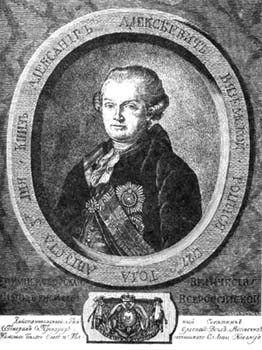
|
The prince A.A.Vyazemsky.
|
Plots of 500 dessiatines (1 dessiatine=1.09 hectare.- Transl.) were granted for each person, there were plots the size of which were 1,000, 1,200, 8,000, 10,000, 15,000, 20,000 and 21,000 dessiatines. Prince A. A. Vyazemsky, Procurator-General, and Prince A. A. Prozorovsky, Field-Marshal-General, each were granted 100,000 dessiatines of land.
How much land Prince G. A. Potemkin grabbed for himself is unknown. Known only is that in 1788 he wrote to V. V. Kokhovsky, the Governor of Yekaterinoslav, such an order: "In the passed year of 1787 I had offered the Yekaterinoslav Vicegerency Management 1,100 dessiatines of land and forests from the Alexandriya District, Glinsk Region, in ravines at the higher parts of the Beresovka and Maka-rikha rivulets registered in the state departments and belonging to LevAlexandrovich Naryshkin, Actual Privy Councilor, Grand Equerry and holder of decorations, to be passed over to his wife Marina Osipovna Naryshkina. But since she didn't send an attorney with a legal warrant for the reception of that tract of land and forests the treasury got no profit. So I prescribe Your Excellency to make orders to leave the mentioned tract of land and forest in my name and after
formalities in measuring the exact boundaries to give me the plan and the legitimate documents for eternal and hereditary ownership."
On January 21, 1789 Prince Potemkin wrote to the Yekaterinoslav Court of Exchequer the following proposal:
"In the past year of 1788 during my ownership of the village of Samotkan, according to the last revision, in it registered were among the Malorossiisky (Ukrainian) peasants 229 men, 190 women, and 419 persons of both sexes. I presented them to the now deceased Mr. Major-General and holder of decorations Ivan Maximovich Sinelnikov for eternal heredity. The land and all the buildings and shops and other villages purchased by me in the Yekaterinoslav Vicegerency were given by me to the department of the crown. And since the peasants have been removed to Sinelnikov's villages situated in Yekaterinoslav and Novomoskovsk districts 1 propose that the Yekaterinoslav Court of Exchequer exclude the above-mentioned number of persons from the village of Samotkan and add them to those villages which had belonged to the deceased Major-General and holder of decorations Sinelnikov considering them belonging to his legatees."
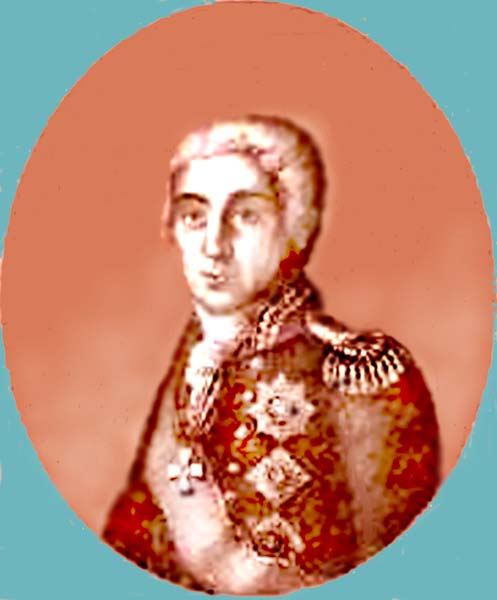
|
The prince A.A.Prozorovsky.
|
There existed a special commission for the distribution of tracts of land. First of all, this commission granted tracts of land only to noblemen. Land was not given to peasants and freeholders. Big landowners and inferior clerks, collegiate registrars, second-majors, archivists were allowed to get some tracts of land. All those who received land got preferential privileges for 10 years, they were free from paying any duties. Then after 10 years it was necessary to pay 2 copecks for, each dessiatine. If one succeeded in settling 13 homesteads on his land of 1,500 dessiatines he got complete ownership of it and could sell or mortgage it to whom he wished. And not only to Russians, the land was given to different foreigners on condition that they became Russian citizens and swore an oath of allegiance.
The Russian Government began to invite foreign colonists to Russia "to widen trade and industry in it" as it was written yet in Empress Yelizaveta (Elizabeth) Petrovna's manifest. But hating the Germans she settled the outlying districts of Za-porozhian freelands only with the so-called "Slavs". Under the reign of Catherine II, after the fall of the Sech, the former Zaporozhye became crowded with foreigners of different nationalities and most of all Germans. They were Bulgarians, Greeks, Georgians, Armenians, Kalmyks, Germans, Moldavians, Walachians, and Jews.
First of all, namely in 1776, the Bulgarians came from Silistra and settled down on the three Tashlyk rivulets, the Vys and the Veliky Ingul rivulets. Later on, that is in 1801, some of the Bulgarians settled along the Dnieper.
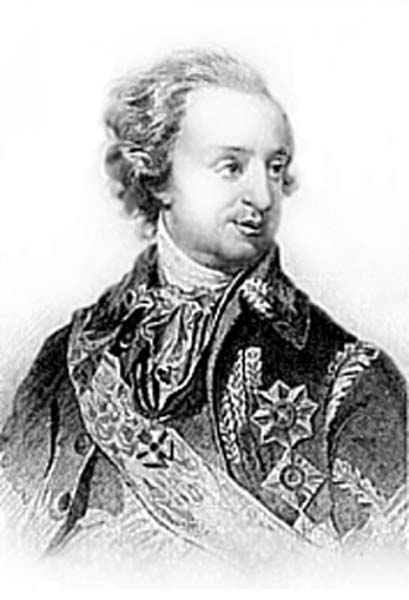
|
The Prince G. A. Potemkin.
|
Then in 1778 to the former Zaporozhian freelands came the so-called Crimean Greeks, that is the Goths who had survived in the Crimea, after that real Anatolian Greeks and Greeks from Minorca Island. All together there were no less than 20,000 Crimean Greeks. They founded 20 settlements along the rivers of Kalmius, Kalchik and Kalka and along the northern coast of the Sea of Azov. On the northern coast of the Sea of Azov they also founded a town named, as it is said, in honour of God's mother Mary - Mariupol. The Greeks, who had come from Minorca Island, settled on the southern outskirts of the former Zaporozhian Samara Palanka (an administrative-territorial unit in the Zaporozhian Sech.- Transl.), nowadays it is called Pavlograd District. They were given cattle, grain, and money for their first acquisition.
In 1779, according to an official deed dated November 14, to the former Zaporozhian land resettled were Greeks, Georgians and Armenians of Gregorian and Catholic religion, who had come under the leadership of Metropolitan Ignaty, Archimandrite Margos and Pastor Yakov. The whole resettlement of the Christians by the government cost 250 thousand roubles. There were 31, 386 persons of both sexes. Among those transferred by Pastor Yakov were Armenians, they came to the suburbs of Yekaterinoslav I, but after a few years when the Crimea became peaceful they moved to the town of Karasubazar.
In 1782 resettled were Kalmyks from the Ural steppes to the Yekaterinoslav Vicegerency (the former Zaporozhye). The number of them in the party was 459 men and 439 women.
In 1786 the first party of German colonists came to the site of the ashes of Zaporozhye. Their arrival had been the trouble and care of Prince Potemkin and Catherine II. The Germans were given the best tracts of land in the Yekaterinoslav, Alexandrovsk and Novomoskovsk districts. Count Rumyantsev-Zadunaisky during his participation abroad in the Seven Year's War took notice of the German Mennonites living in Prussia, especially near Danzig and Elbing, who were famous for cattle-breeding. After his return to Russia he reported about them to Empress Catherine. Being aware that with the growth of the number of Mennonites they would need much more vast and rich soil than there had been in Western Europe, the Russian Government under Catherine II sent Collegiate Councilor Trappe on a mission to invite some Mennonites to the vast fertile steppes on the Novorossiisk territory.
The Mennonites concluded an agreement with the Russian Government after which in 1786 500 men and 400 women, later on in 1789 228 families arrived in the Novorossiisk territory. At first the newcomers were settled on the banks of the Konka River and then they were given tracts on the Bolshaya (Great) Khortitsa Island and on the right bank of the Dnieper, a little above the island. Each person got 65 dessiatines of land. In the above-named places the settlers founded 8 colonies under the name of "Okrug (region) of Khortitsa". On June 23,1790 Prince Potemkin issued an order giving the right on the settlers' request to move over from Novomoskovsk (where they had lived before) two small churches that were left vacant after the Greeks and the Armenians had gone. The very name of Yekaterinoslav I had disappeared entirely and instead of it in 1789-1790 the Josefstal colony was formed. In 1793 a new group of German migrants consisting of 273 men and women arrived.
At first they settled down in Stary (Old) Kodak and then founded the village of Yamburg at the distance of 17 versts (1 verst=3,500 feet - Transl.) from the town of Yekaterinoslav.
In 1788, 1789 and 1792 159 Moldavians from the ravaged villages of Slobodzeya and Karatash came to the Yekaterinoslav Province, there came also from Korotnaya 31 Wala-chians and from the free village of Yaska 25 people, in all 215. In 1792, already after Prince Potemkin's death, Catherine II wrote by herself: "The Moldavian boyars, who have become our citizens, deserve receiving land there (that is in Novorossia)."
In 1793 Jews, whom Empress Yelizaveta Petrovna did her best to prevent their coming to Russia, also rushed to the former freelands of the Zaporozhian Cossacks. Under Catherine II they came to the Novorossiisk territory after the second partition of Poland when, excepting the western part of Volyn, Russia was given Byelorussia and Southern Rus.
The Russian crown granted the foreign settlers 250, OOP roubles as aid for the beginning of farming.
Besides foreign migrants, transferred to the former Zsàporozhye region were settlers from Great Russia. For examplfc from Great Russian provinces having insufficient arabL land at the crown's expense brought were "economic" and "state" peasants. The landlords, granted plots of land on the Novorossiisk territory, resettled there their own serfs from the Great Russian patrimonial estates. The Old-Believers were allowed to resettle on the left bank of the Dnieper at the place where the Belozyorka River falls into it. There they founded a large village of Belozyorka. Permission was given to other sects too, such as the Molokans and the Deniers of the Divinity of the Holy Ghost. Once in a while exiled to the Novorossiisk territory were criminals sentenced to punishment.
By 1784 distributed in all were 4,470,302 dessiatines of the Zaporozhian land.
Chapter II
Simultaneously with the distribution of the Zaporozhian land in the region begun was he construction of such towns as Kherson, Yekaterinoslav, Nikolayev and others. All the buildings were to be large in width and height. But of all the towns Yekaterinoslav was to glorify Empress Catherine II and perpetuate her name forever. In order to foundYekaterinoslav at first chosen was a site at the mouth of the Kilchen River falling into the Samara River, a left tributary of the Dnieper, where the village of Losha-kovka was situated, that is 3 versts above the Starosamars-ky (Old Samara) retrenchment or the Bogoroditskaya fortress (now 5 versts above the Samara railway bridge). The town was founded by Governor V. A. Chertkov in 1777. He considered this site the most convenient place approachable for various vessels.
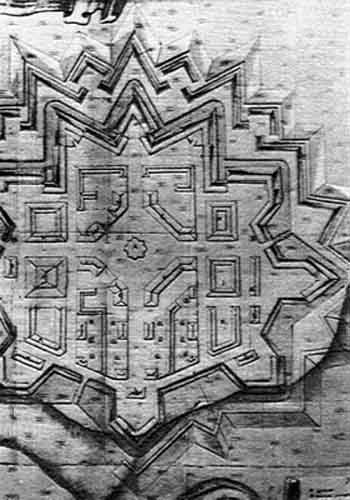
|
The Yekaterinoslav I of 1775.
|
On May 10, 1778 Bishop Yevgeni Bulgaris laid the foundation of a church on an appointed site in memory of the Descent of the Holy Ghost upon the Apostles. The church was built by people belonging to the crown out of crown-timber and was finished on October 14, 1778. In the beginning of June 1778 Governor V. A. Chertkov moved over into the new town with, all the departments of the Azov Province office.
In 1782 the town of Yekaterinoslav consisted of 2,194 inhabitants, and there were 4 churches: Russian, Greek, Catholic and Armenian. There were also 2 schools: one for the children of the gentry and the other for the children of the raznochinetzes' (intellectuals not belonging to the gentry in the 19th century in Russia.- Transl.). There they were taught Russian Grammar, German, French and Turkish languages, Catechism, also Arithmetic, Geometry, History, Instrumental and Vocal Music. In order to attract merchants to the town opened were 4 fairs. Besides that, on Sundays it was allowed to hold auctions to which not only the inhabitants from neighbouring places came, but also traders from the Crimea.
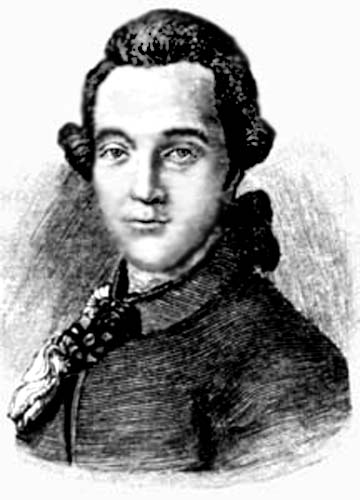
|
The architect M. F.Kazakov.
|
In March 1783 by the order of Empress Catherine II at Prince Potemkin's disposal sent was a famous contemporary artist and architect M. F.Kazakov to "correct charged matters". Kazakov came to Yekaterinoslav with his assistant Ivan Yegotov, but the practice and the squad of architects entrusted to him he passed over "to be led" by another assistant - Ensign Polivanov. Kazakov stayed in Yekaterinoslav up till December 1783, then he was sent back to Moscow"because of his illness". While living in Yekaterinoslav Kazakov took an active part in planning the construction of the new town. However, the site of the town chosen by Governor V. A. Chertkov turned out to be unfit for residence. First of all, the land was flooded over every springtime. When the spring waters left, swamps remained which had a dangerous effect upon the health of the inhabitants.Secondly,the navigability of the Samara River turned out very poor.
Only very small merchant boats could come up to the bank and larger ones couldn't at all.

|
Jekaterinoslaw I am 1783.
|
A report about the inconvenient location of the town of Yekaterinoslav was sent to the capital. Then a staff doctor Schonvogel arrived from Moscow to inspect the town and its suburbs. On arrival Schonvogel examined the town and confirmed the facts of all the named inconveniences and danger for the residents of the site which was chosen for the town.
Then orders were issued to move Yekaterinoslav I over to a site higher, to the Bogoroditsky retrenchment, which was also called Old Samara, and to name it as a district town of NovomosKovsk. It occupied the place of Novoselitsa and "swallowed it".
Meanwhile by orders dated March 30,1783 and January.22, 1784 instead of the former Novorossiisk and Azov provinces Catherine II commanded to establish the Yekaterinoslav Vicegerency consisting of 15 districts and appointed T .icntenant-General T. I. Tutolmin its ruler. She ordered to choose the site for the town of Yekaterinoslav II on the right bank of the Dnieper, there where His Highness Governor-General of Yekaterinoslav, Saratov and Astrakhan regions Prince G. A. Potemkin would point out.
Prince Potemkin chose the site for the town on the right bank of the Dnieper on the place where the Zaporozhian settlement (often inhabited by free, non-serf peasants.- Transl.) of Polovitsa had been, between the free villages of New and Old Kodaks. After dismissing Lieutenant-General T. I. Tutolmin he appointed Brigadier, later on Major-General I. M. Sinelnikov in his place. Sinelnikov temporarily was to live in the town of Kremenchug as well as the vicegerency board of administration was to be located there with all the government offices.
On September 23, 1786 Prince Potemkin wrote to Sinelnikov: "Due to the inconvenience of the present town of Novomoskovsk (of course the same Yekaterinoslav I) which because of its low location is often flooded by the Dnieper (causing the residents great distress and ruins and preventing other people from settling down there), I recommend Your Excellency to transfer that district town like my former one to the highest place - to the Bogoroditsky retrenchment. The merchants are to be given full freedom in living there or moving to the new Yekaterinoslav for which to organize district judicial bodies in Novomoskovsk on this newly chosen place. All the Armenians living there are to be resettled to this provincial town and provided with profit and aid from the state. The existing state buildings in Novomoskovsk,
after separating a part for the judicial places in the district town and passing over to the Bogoroditsky retrenchment, the rest to be passed over to Yekaterinoslav, those unnecessary should be sold at auctions."
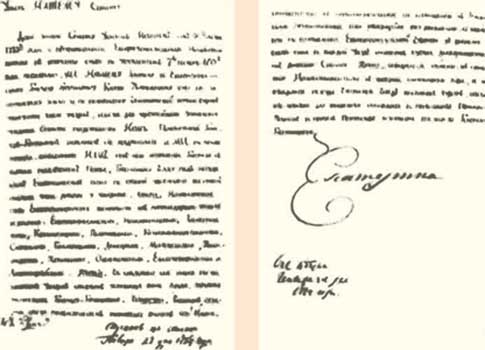
|
The empress's decree on founding the provincial town of Yekaterinoslav.
|
From this order, by the way, we can see that Prince Potemkin had foreseen the inconvenience of the site for Yekaterinoslav I formerly.
On October 10, 1786 Prince Potemkin wrote to the ruler of the Yekaterinoslav Vicegerency I. M. Sinelnikov again: "Having proposed to the Yekaterinoslav Court of Exchequer to grant Your Excellency two hundred thousand roubles for the construction of the provincial town of Yekaterinoslav, I order yor after receiving the mentioned sum to immediately get down to preparation of materials and foodstuffs, as much as possible, stored under hand in a place appointed by me (where situated now is the village of Polovitsa). Your Excellency must also take measures for finding artisans and labourers so that in such a way there would be nothing to prevent the beginning of work on the construction of the new town devoted to glorifying the name of our great autocratrix."
By granting the sum of money for the erection of the town of Yekaterinoslav in the order dated October 10 of the same year Prince Potemkin fixed board-wages of 250 roubles a month personally for Vicegerent I. M. Sinelnikov.
What was Yekaterinoslav to look like may be seen in the plan of the town drawn by Prince Potemkin in his own handwriting and submitted for approval to Empress Catherine II. "By kneeling reverently and handing the project of constructing the town of Yekaterinoslav to Your Imperial Majesty, I dare to beg to be granted all the sums of money left after the expenditures of the province in order to carry out the project. This part of your empire, so to say, yet in its infancy maintains all the officials and the expenditures for the vicegerency, paying out the three-million sum for the construction of the forts in Taurida and the remaining will be enough for the erection of the famous town.
Your Majesty, where else if not in the country devoted to your glory can the city be of magnificent buildings? That's why I got down to drawing projects worthy the high name of the city. First of all, submitted is a splendid cathedral dedicated to the Transfiguration of our Lord as a sign demonstrating that the country of fruitless steppes has been transformed under your care into a bounty garden, a dwelling-place for animals into a favourable refuge for people coming from all existing countries. A court-house like ancient basilicas in memory of your helpful instructions. Benches in a semicircle like the propylaea in Athens with a stock exchange and a theatre in the centre. A palace for the tsarina, where the governor could live too, in the style of Greek and Roman buildings,
having in the centre a magnificent and spacious entrance-hall. An archbishopric at the Transfiguration Cathedral with a consistory and an ecclesiastical school. Since this province is military there should be an alms-house for merited old soldiers to be taken care of and for invalids with all possible advantages and deserved splendour. A governor's house, a vice-governor's, a house for the nobility, a pharmacy. A cloth factory and a silk-weaving mill. A University with a musical academy. Quite a lot ofvari-ous supplies have been stored for the construction of all the buildings."
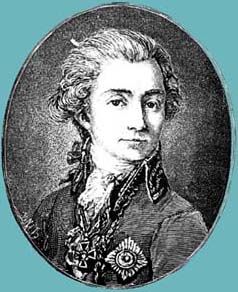
|
I. M. Sinelnikov
|
Meanwhile, having received the order to transfer the former town of Yekaterinoslav I and to rename it into Novomoskovsk, the ruler of the Yekaterinoslav Vicegerency I. M. Sinelnikov was in a haste to carry out His Highness's order. In olden times as well as among the people and in documents the town of Novomoskovsk was called Samara, Samarchuk, Samarchik, Novoselitsa, Novosyolovka. The first dwellers of Novoselitsa had moved over from the neighbouring town of Old Samara where situated were the headquarters of the Russian forces. It was to that Novoselitsa that the former Yekaterinoslav I called Novomoskovsk was transferred. In it in 1787 opened was the first six-men's Duma (Town Council). Part of the residents of the former Yekaterinoslav I moved over to the right bank of the Dnieper,
to the village of New Kodak and another part left for the Black Sea coast. The land which remained was passed over to the German colonists who founded there two colonies Josefstal and Kronsgarten in 1789-1790.
Thus began "the existence of the town of Yekaterinoslav II or a real city of great hopes and glory with the aim of perpetuating the name of Empress Catherine II." A great number of workers was necessary for the construction, various crafts-masters, contractors, foremen, superintendents, stewards, technicians and others, but they had no living quarters in the newly growing-up town and there couldn't be. These people had to find lodgings in the nearest to the future town village of New Kodak.
The village of New Kodak had once been an old Zaporo-zhian settlement known ever since 1660. In 1750 the village was mentioned in the documents of the archive in Zaporozhye as a town. At that time the town of New Kodak was the ruling centre of the Zaporozhian Kodak Palanka because it was situated at the very crossing on the Dnieper River near the trodden tchoomak (Ukrainian ox-cart driver.- Transl.) high road. By the end of the 18th century the population of New Kodak increased greatly when the Cossacks came from the Sech and settled down in it forming families and changing weapons for ploughs to raise the fertile and rich soil.
After the arrival of great masses of people in New Kodak, who took part in the construction of Yekaterinoslav, the number of inhabitants there increased still more. From 1787 to 1791 replacing the future city New Kodak in some documents and orally was often called Yekaterinoslav II.
Three-four versts down the river from New Kodak there was a small Zaporozhian free settlement called Polovitsa. Polo-vitsa got its name undoubtedly from the rivulet Polovitsa which flowed by there. The rivulet began its course from the site of the contemporary Ozyorny (Lake) market along a trough at first, then along the prospect (where there is a gutter now) and then, turned to the left little by little, joined another trough flowing down from Zhandarmskaya (Jendarme) gully (it was called Kaznacheiskaya before), it went down through " another gutter, about a verst long, passed parallel to the Dnie-? per separating a rather large peninsula and at last joined the river itself at a distance of 500 -550 sagenes(l sagene=2.134 metres.- Transl.), but not reaching Monastyrsky Island (now called Bogomolovsky Island).
In various documents of the 16th-18th centuries and in the works of Ukrainian writers the word "polovitsa" meant "half of anything no matter what": half of the army, tax in money, window-pane (made at a plant for sale), half of the fish caught, half of a watermill bought, half of the property.
So the rivulet flowing parallel through two river-beds got the name of Polovitsa, and from the rivulet the settlement got its name. It is known that very many towns have been named from the rivulets on which they are situated: Moscow from the Moskva River, Tver from the Tvertsa, Vologda from the Vologda River, Kursk from the rivulet Kur, Volchansk from the rivulet called Volchyi Vody, Kupyansk from the Kupyanka and Akhtyrka from the Akhtyrka River.
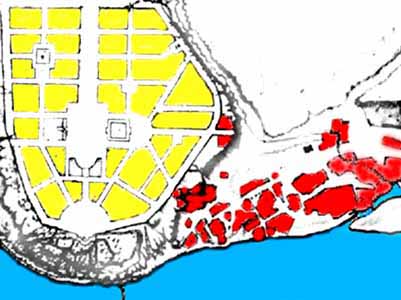
|
The Polovitsa village.
(1786 - 1788).
|
The Polovitsa village itself is of much later origin. The settling ofif began in about the middle of the 18th century. In 1768, after an attack of the Tatars upon the Zaporozhian Sech, a part of the wintering Cossacks rushed to the north to the Kodak Palanka and settled there at the Polovitsa rivulet. A part of the Cossacks who were unable to flee with their comrades beyond the Danube River also settled down there to live out their days on their own home ruins. To Polovitsa moved also some of the retired Cossacks from New Kodak, for example, the former Zaporozhian Esaul Lazar Globa.
At last, different people from Ukraine ruled by Poland also found shelter in Polovitsa.
On the plan of Yekaterinoslav in 1786 the settlement of Polovitsa is shown in the lower part of the town (nowadays bordering approximately from Yakovlevsky Public Garden to Kudashevskaya Street and in Kamenya up lo Potemkin Garden, along the Polovitsa rivulet). Two gullies - Voitsekhov and Bobyrev - crossed the settlement of Polovitsa (now they are called Fabrichnaya and Aptekarskaya) along which the Poles and the Ukrainians settled down. As to the question of how many farmsteads and inhabitants there were different researchers give various data. In the book "Materials for the Historical and Statistical Description of the Yekaterinoslav 8 Diocese" in 1779 shown were 125 farmsteads. In "The Chronicle of the Yekaterinoslav Archive Commission" for 1783 professor V. A. Bednov gave the data 113 1/4 farmsteads.
In the materials kept in the local regional archive for 1784 "recorded were in Polovitsa state settlers living by farming: 400 men and 302 women. Occupied in unskilled work: 38 men and 31 women. Farmsteads (according to the number of huts): wooden - 50, clay covered - 80. There were 5 water-mills and 3 smithies." When it was decided to transfer the main vicegerency offices to Polovitsa the governor of the non-yet-existing town of Yekaterinoslav composed a "Description of the Outskirts of the Town of Yekaterinoslav and the Residing There People of Various Ranks and so on". In that book he wrote not only about Polovitsa but also about Old and New - Kodaks and the Kamenka (Lotsmanskaya) settlement. "All the surrounding land consists of 39,000 dessiatines. Polovitsa is situated on the very bank of the Dnieper River, on the banks of numerous winding bays... Fishing is free of charge and there a great variety of many fishes could be caught. During the year 5 fairs take place here.
Milk products of different kinds brought from the Crimea, Poland and Russia are bought by the local residents. In all, in Yekaterinoslav and its suburbs live 1,981 men and 1,639 women." Since the foundation of the town up till 1790 in the settlement of Polovitsa, where the provincial town of Yekaterinoslav is now situated, the parish numbered 155 farmsteads with 1,450 men and women living there.
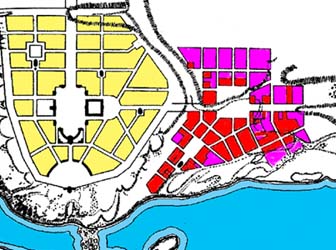
|
The Polovitsa village.
(1792).
|
In 1779 the residents of Polovitsa, belonging to the parish of the New Kodak church, turned to Bishop Nikifor asking for permission to have a wooden church for the sake of Peter and Paul built for them in their free settlement. Among the applicants named in the church archives were former captains of the Zaporozhian troops Lazar Globa, Ignat Kaplun and Andrei Mandryka, former regimental comet Danilo Kasalap, churchwardens Fyodor Kroshka and Fyodor Skok, clerk Vasily Kiyanitsa. The permission was given, and the foundation was laid in 1781, the church was erected in 1783. It remained only to sanctify the building and to perform a divine service in it, but before it was done the building caught fire and burned down, the reason remained unknown. They managed to save the iconostasis and all the church plates because the fire broke out not inside the church, but on top of it. It happened not at night, but at one in the afternoon.
After that the residents of the settlement of Polovitsa built for themselves a chapel (prayer house) and named it after the Kazan God's Mother and it served them for a long time instead of a church.
When in 1786 the construction of the town of Yekateri-noslav was begun great many skilled masters arrived in Polo-vitsa. Then little by little a resettlement of residents of Polovitsa to neighbouring free lands started. One part of them was moved down the hill and sailed down the Dnieper, another part rose up the Dnieper to the Sukhachovka settlement. During the period between 1791-1793 the provincial town of Yekaterinoslav finally occupied for good the site of the former Zaporozhian village of Polovitsa, but still for a long time the local old residents kept in their mind and their tongue the Zaporozhian settlement of Polovitsa, and when someone of the old-timers intended to go to town then he did not say that he was going to Yekaterinoslav, but to Polovitsa.
By the will of the omnipotent and absolutely powerful Prince Potemkin instead of the remote God-forsaken Zaporozhian settlement of Polovitsa there was to rise a grand magnificent shining in beauty and wealth city of Yekaterinoslav which would serve as an eternal and worthy memorial of the immortal deeds of Grand Monarchess Empress Catherine II.
Prince Potemkin's projects were really gigantic.
Chapter IV
On January 6, 1787 Empress Catherine II left St. Petersburg for Kiev. In Kiev she stayed till April 22 and on the same day started to sail down the Dnieper River to the site of the future city of Yekaterinoslav.
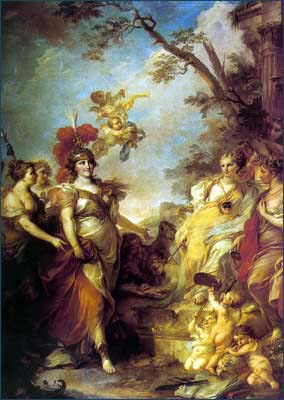
|
The passing of the Empress Catherine II.
|
The Empress was accompanied by a brilliant retinue of ladies and gentlemen, Russians and foreigners. On her way she had decided to grant an audience to Stanislaus Augustus Ponia-towski, the King of Poland, and then to meet with the Emperor of Austria Joseph II who was travelling in Russia under the name of Count Falkenstein for negotiations on various political affairs.
In the suite of the Empress in all there were 40 personages: her chambermaid of honour Anna Stepanovna Protasova, the chamber-woman Mavra Savvishna Perekusikhina; Princess Golitsyna, Princess Dolgorukova, Countess Branitskaya, Countess Skavronskaya, Countess Chemyshova and others. Then Prince Potemkin, Count Dmitriyev-Mamonov (or else Red Kaftan), who was a favourite of Catherine II from 1786 to 1789, Prince Baryatinsky,.CountChemyshov, Count Shuvalov, Count Rumyantsev, Count Bezborodko, Count Anhalt, Na-ryshkin, chamberlains Valuyev and Saltykov and others. Among the foreign special personages - the Austrian envoy Count Kobenzel, the French Prince de Ligne, the French diplomat Count Segur, Prince Nassau-Siegen, a British plenipotentiary Fritz Herbert.
Besides, the Empress herself and the little Countie Branitsky, who amused Catherine very much by his funny childish actions, jolly pastimes, jokes and ready wittiness. On another galley Prince Potemkin was accompanied by a famous poet Petrov who was the Prince's companion and always followed him everywhere. In order to fix on paper and on canvas the most important moments of the great persons' voyage down the Dnieper invited was Hatfield, an artist.
Furthermore, the Empress was escorted by delegates of 30 peoples under the Russian rule - from the Tatars, the Kalmyks, the Kirghiz, the Ossets, and other peoples of various levels of culture, different civilizations, morals and manners, communal life, physiognomies, languages and dialects, religion and attire.
The royal river flotilla consisted of 80 vessels with 3,000 sailors under the command of Vice-Admiral Pyotr Ivanovich Pushchin. The vessels were gilded, decorated with Cupids, twined with great many different flowers, gay with many-coloured flags; amazing everybody was a whole forest of tall and well-proportioned mast timber.
Each vessel was named after the name of the rivers in the Russian Empire. For example, the ninth galley in the row of vessels on which Empress Catherine was sailing carried the name of the Dnieper River "Dnepr". It was the most splendid, the pavilion of which was decorated with red velvet, embroidered with golden thread. The tenth galley following in the row was "Bug", after the Bug River. It was occupied by Prince Potemkin and his nieces Countess Branitskaya and Countess Skavron-skaya with their husbands. The mobile dining-hall was set up on the galley "Desna". "It is difficult to imagine," said a witness Count Segur, "a vessel more magnificent, more elegant and more luxurious than this one." On one of the galleys sailed a doctor and a chemist with all kinds of medicine and equipment.
The royal flotilla was followed by a multitude of different small boats (dug-outs, canoes, and other kinds) which were there to see the flotilla off.
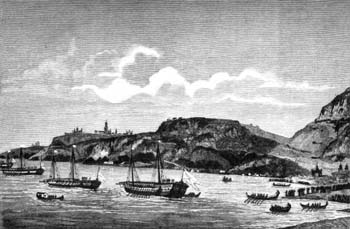
|
The royal flotilla.
|
On the galleys there were 200 singers and musicians conducted by Sarti, the Director of the Yekaterinoslav Musical and Art Academy.
Great admiration was stirred up by music performed on horns. The horn playing fascinated even the Emperor of Austria Joseph II who called it "divine while the rest was looked upon ironically."
Separately, Prince Potemkin had also 186 singers and musicians on his own galley.
There is a shrill trumpet call,
There is a thunder of drums.
There groan the French horns
Shaking the air in harmony.
There's the sound of reed-pipes
And loud warbling through them
From time to time sounding
Like the nightingale's whistle
Through the noise of water falling.
Everywhere on the banks of the Dnieper bright and many-coloured lights were burning, mighty and endless cries of joy of the people were ringing. Everywhere as if springing up out of the earth were palaces, buildings, towers, triumphal arches. During one night there appeared wonderful gardens; in different places Muses performed with harps and flutes, greeting "the Northern Goddess" and charming her ears with melodies.
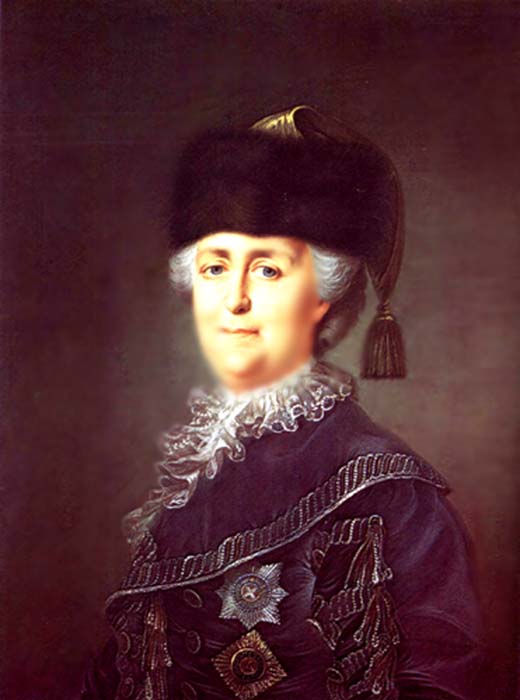
|
P.G.Jàrkow.
Catherine II of the passing.
1788.
|
The foreign ambassadors who had seen all kinds of wonders in the West couldn't close their mouths with surprise and held their breath with delight. This rapture was expressed in the travel notes of the French diplomat Count Segur, one of the participants of the voyage with Empress Catherine II. He wrote: "The Empress started on her way in a galley escorted by a most magnificent flotilla which had ever sailed on a wide river. It consisted of 80 vessels with 3,000 sailors and soldiers. In front moved down seven very large smartly decorated galleys skilfully painted and a great number of very able sailors dressed alike. The cabins built on the decks shone in gold and silk... Each qfus had a room for himself and yet another for a study splendidly and richly furnished in which there were comfortable sofas and a beautiful bed under a damask curtain and a mahogany writing-desk. Each galley had its own music.
A multitude of large and small boats rushed in front and about the whole squadron which seemed to have been created by magic."
"We moved down the river slowly, stopped frequently and, taking advantage of it, often passed over into the light vessels and sailed along the banks, around the small green-covered islands with which the river was studded. Great many people greeted the Empress in loud voices when under the thunder of cannons the sailors regularly beat the waves of the Borysthenes with their brightly painted oars. Crowds of curious people gathered along the banks endlessly changing and appearing from all sides to have a look at the ceremonious procession and to present the Empress with works of art produced by them in different localities. Now and then light units of Cossacks held manoeuvres on the open plains near the river. The towns, villages, farmsteads, estates, and sometimes common huts were so heavily decorated with flowers, wall-paintings and triumphal arches that the view deceived the eyesight and they looked as if they were wonderful towns created by magic.
The snow was melting; the soil being covered with verdure; the meadows being sprinkled with flowers; the sunrays brightened up and animated everything surrounding and all seemed beautiful. The harmonic sounds of music from our galleys, the various costumes of the spectators, standing on the banks, diversified this luxurious and lively picture."
"When we approached large towns in some places excellent regiments shining with their weapons and in rich attire were lined up in front of us. By this way, the elements, nature, spring, and art seemed to have joined together stressing the triumph of the great favourite (Potemkin). By surrounding the Empress with such wonders during her travels across the countries recently subjugated with the help of arms he hoped to rouse her self-esteem and stimulate in her a wish and courage in determining ventures upon new conquests."
"I have never seen the Empress more amiable than on the first day of our voyage... Spring made our minds younger... The firm belief in seeing some new, curious things day by day, all this was exciting and provoked our imagination which in its aspiration outstripped us."
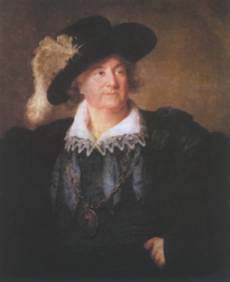
|
Stanislaus Poniatowski, the King of Poland.
|
Moving further down the Dnieper on April 25 the flotilla stopped opposite the town of Kanev where Catherine II received Stanislaus Poniatowski, the King of Poland, who had come with his suite for a mutual elucidation of various political problems. He had expected to be received by Catherine as Prince Poniatowski, with whom she had once been in close relations, but since 29 years had passed Catherine met him with very great restrain. After mutual bowing, which was with an air of importance, proudly and coldly, Catherine shook hands with the king, after which they entered the study and stayed there only half an hour.
The king left the study with a sad expression in his eyes that could not be hidden by his forced smile, and after that he entered the reception hall crowded with a gathering of high personages headed by Prince Potemkin.
A few minutes later Catherine II came out and entered the hall.
She was dressed according to Slavonic style. Her garment, a kind of a polish surcoat, was of silk material interwoven with gold and red in colour, surrounded by golden embroidery, with long sleeves thrown back. Her hair was skilfully done with a few pins and an egret-plume with an unusually large diamond; on her chest was the ribbon of St. Andrew shining with diamonds above the stars of St. George and Vladimir.
After a mutual presentation of the officials according to their rank the king was invited to dinner and later on at 8 p.m. of the same day returned to Kanev where he gave a brilliant ball to the suite of the Empress in which, however, Catherine herself refused to take part.
When it became quite dark at night the Kanev Hill suddenly blazed up with bright dazzling lights; a canal had been dug out on the slopes of the hill and filled with combustible matter. When set on fire it looked like lava flowing down from a volcano, more so, the resemblance was even greater because of an explosion of 100,000 rockets on top of the hill illuminating the surroundings and doubling the brightness by being reflected in the water of the Dnieper. The fireworks displayed the image of Mt. Vesuvius' eruption and was very excellently performed. The whole flotilla was so wonderfully illuminated that there was no night at all for anybody.
But beginning from April 26 such terrible westerly winds rose on the Dnieper that at times they turned into real storms. Once during such a heavy storm the "Dnepr" galley, on which the Empress was, became pressed to the bank of the river, but at last everything settled down safely and well and Catherine II prohibited giving any reports about it officially.
Besides the storm, many islands, isles, turns and in places rocks, hidden under the water of the river, hindered the movement of the galleys which had to be rowed with oars without sails. There were times when the storms calmed down and then nature performed with all its charm and beauty.
On the 29th of April the flotilla stopped opposite the small town of Krylov where the Yekaterinoslav Vicegerent I. M. Sinelnikov, the province's leader, district marshals of nobility and many nobles had gathered to meet the Empress.
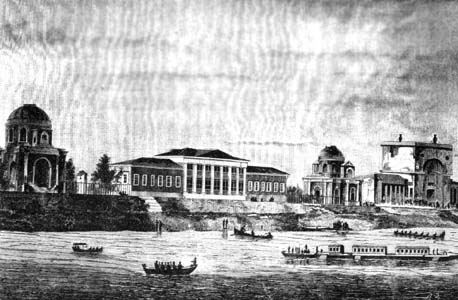
|
The royal flotilla in the town of Kremenchug.
|
On the 30th of April the vessels of the flotilla cast their anchors in very fine weather at the landing-stage of the town of Kremenchug where the Empress was met by Prince Potemkin as Governor-General of the region and by Yekaterinoslav Archbishop Amvrosius.
"All the trees," wrote Catherine from Kremenchug to the capital, "even an oak-tree, spread out (heir branches and it is so warm as it is in June in our capital; in general, ever since we have entered the Yekaterinoslav Vicegerency the air and all things and people have changed their appearance and everything seems more lively."

|
F.Sideaux.
The Prince G.A.Potemkin.
1782-1784.
|
The reception organized by Prince Potemkin for Empress Catherine in the town of Kremenchug positively enraptured both her personally and her suite and all the foreign visitors. After she had inspected the troops in a burst of enthusiasm she said to Potemkin: "From Petersburg to Kiev it seemed to me that the mainsprings of my empire had weakened from long use, here they are full of strength and action."
"Potemkin, unusual always and in everything," says Count Segur, "has been here as much active as he had been lazy in Petersburg. As if by some sorcery he could overcome all obstacles, conquer nature, shorten distances, hide defects, create optical illusions there where only monotonous sandy plains exist, give food for thought during the long way and enliven the steppes and deserts. The stations were situated in such a way that the travellers could not become tired: the fleet always stopped in view of villages and towns located in picturesque places. Numerous herds were browsing in the meadows; crowds of inhabitants came upon the banks of the river; we were surrounded by a multitude of boats with young men and girls who sang folk songs; in a word, nothing was forgotten. It is necessary to agree with the fact that though Potemkin was a poor military leader,
a self-willed diplomat and really not a stateman, nevertheless he has been really the most remarkable and the cleverest courtier."
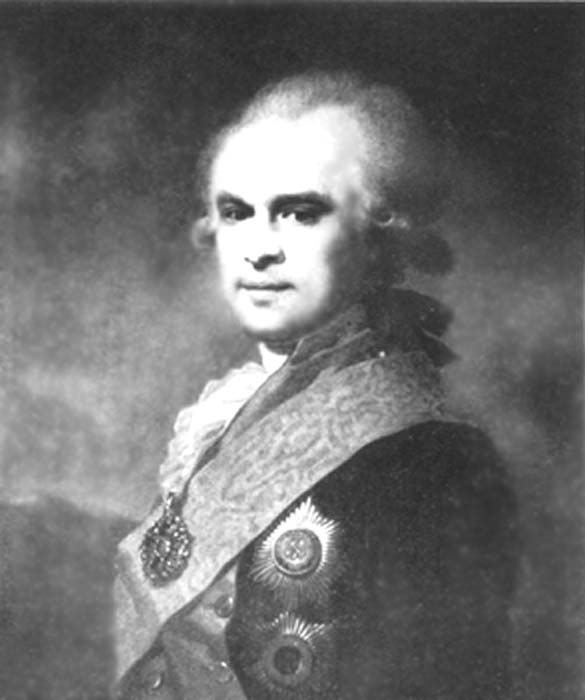
|
Jogann Baptist Lampi the Elder.
B.C.Popov,
is Prince Potemkin's private secretary.
|
"I had been," wrote V. A. Chertkov, a participant of the voyage of Catherine II down the Dnieper, "with His Highness to Taurida, Kherson and Kremenchug about two months before the arrival of Her Majesty there. His Highness surprised me and I could not understand what it was that he wanted to show to Her Imperial Majesty. There was nothing worth seeing anywhere, in a word, I was sorry that His Highness had invited Her Majesty in vain. But when I arrived there in the suite of the Empress only God knows what wonderful things had appeared. The devit- knows from where buildings, troops, people, the Tatars beautifully dressed, the Cossacks, ships had appeared. Well, well, God knows that... What an abundance of viands, drinks, in short, everything. Well, you know, it is beyond imagination even to be able to relate as it should be. I walked about as if in a dream, it was as if I was sleeping.
I myself believed nothing, I felt myself trying to find out whether it was me, where was I? Maybe it all was a dream? Or maybe I saw a ghost? Well, I must tell the truth: only he, only he alone could have done such things, and when did he manage to do all this? It seems in Kiev he was not very busy either, just as he is here too. Only one could hear "Vasily Stepanovich" and "Popov" or "Popov" and "Vasily Stepanovich". But that was one and the same person. 1 Was it a surprise? Yes, it was. Maybe some spirits serve him?"
On the 3rd of May, after the flotilla had left the pier of Kremenchug, again strong westerly winds began to blow hard hindering the movement of the vessels down the river. These winds, having developed their strength during a few days, forced the flotilla to stop and spend the night on May 6 at the right bank of the Dnieper opposite the village ofGrigoryevka (now the town ofVerkhnedneprovsk).
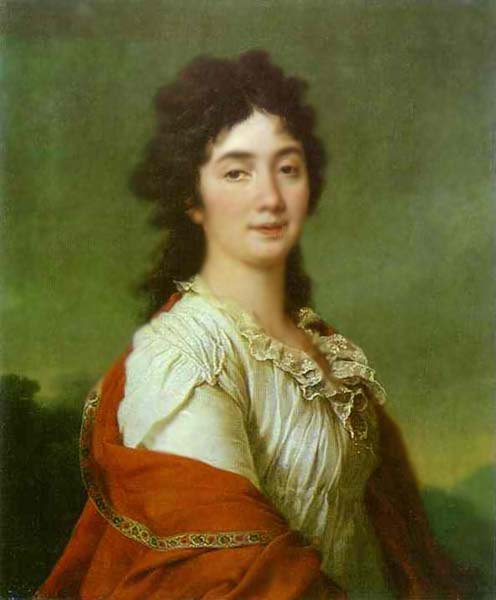
|
D.G.Levitsky.
The Countess A.S.Protasova.
|
On May 7 quite unexpectedly for everybody Catherine's voyage down the Dnieper stopped and was over altogether.
At 4 a. m. the flotilla had hardly left the village of Grigo-ryevka when about an hour later there appeared a carriage on the bank of the river and a shout was heard demanding to send a boat to the bank. When the boat reached the bank Count Rumyantsev sprang into it and he was rowed to the "Dnepr" galley onto which he climbed. Only three days before he had been sent to meet Emperor Joseph II who had come for an appointment from Catherine II. Now the count had driven to report about that to the Empress, but she ' was still asleep and during a long time no one dared to wake her up. At last with the help of Mavra Sawishna Perekusi-khina the Empress was told about Count Rumyantsev's arrival with the news that the day before Count Falkenstein had come to the village of New Kodak and was now on his way from there riding to meet her.
It was already 11 a.m., it was necessary to hurry. A great turmoil broke out. Carriages and horses were brought. Catherine with Countess Branitskaya, Count Dmitriyev-Mamonov and Prince de Ligne took their seats in a barouche. They were followed by Protasova, Lev Naryshkin, Count Bezborodko, Anhalt, Rumyantsev in a six-seater carriage. Prince Potemkin had gone directly to New Kodak to receive both sovereigns.
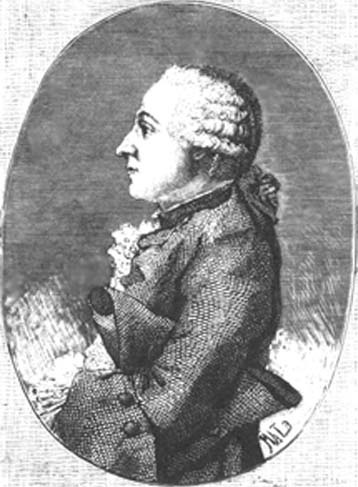
|
Baron M.Grimm.
|
Catherine II described her meeting with Joseph II in a letter addressed to Baron Grimm in Petersburg:
"On the 7th of this month (May) being in my galley beyond the Kodak village I learned about Count Falkenstein's galloping at full speed in order to meet me half-way. I came out onto the bank and also immediately rode towards him and we both did it so zealously that we met nose to nose on an open plain. His first words were:'Look what all our diplomats have missed. Not a single one will be able to witness our meeting.' He was accompanied by his envoy and I with Prince de Ligne, Red Kaftan (that is Dmitriyev-Mamonov) and with Countess Branitskaya."
"Their Majesties took seats together in one carriage 2 and with great speed drove away to Kodak, 30 versts away without stopping. But after rushing away so swiftly and quite alone through the plain (he expecting to dine at my place, while I had counted on dining at the Field-Marshal Prince Potemkin's place, but Potemkin had planned to fast saving time for the preparation of the ceremony of laying the first stone in the foundation of the new city) we found Prince Potemkin who had just returned from his trip and there was no dinner. But since need makes people inventive Prince Potemkin ventured to become a cook by himself, Prince Nassau as a kitchen-boy and General Branitsky as a pastry-baker, so their
Majesties since the very day of their coronations had never yet had such brilliant servants and such a bad dinner; in spite of it they ate, laughed much and enjoyed the dinner prepared in such an unusual manner."
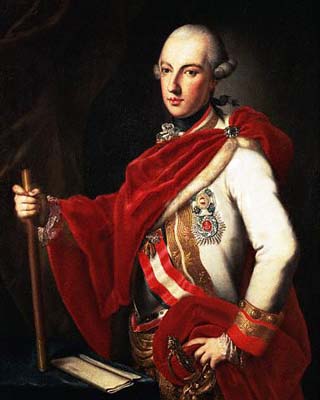
|
The Emperore Joseph II.
|
Emperor Joseph II himself described his meeting with Catherine II in a letter to Field-Marshal Lassi on May 19 (by new calendar) in the following way: "My dear Marshal, taking advantage of some free time I am writing to you from a Zaporozhian village (Kodak). The Empress was unable to continue her voyage down the Dnieper yesterday because of stormy weather... At that time I was galloping to meet her on her way and we met at a distance of 1/4 verst away from her flotilla. 3 She invited me into her carriage and we turned back to Kodak. Here we found that all her servants had fallen behind and that's why there was nobody to prepare our meals, lay the table and serve us.
Then Prince Potemkin, who had arrived ahead of us with his companion Prince Nassau, and Polish General Branitsky undertook to cook by themselves. There was a kitchen-boy with me; I wanted to send for him, but they prevented him to interfere and due to this our dinner was a mixture of dishes of very bad taste..."
In the magazine "Chamberfourrier" of 1787 we can read about the meeting of Catherine II and Joseph II the following: "Three versts away from Kodak there took place a joyful meeting between Her Imperial Majesty and Count Falkenstein which was so pleasant to watch that when the two great travellers had hardly been seen in the two carriages driving towards each other, without hesitation at quite a distance they stopped, got out of their carriages and walked towards each other and having joined performed mutual friendly greetings, both took seats in the carriages of Her Imperial Majesty. 4
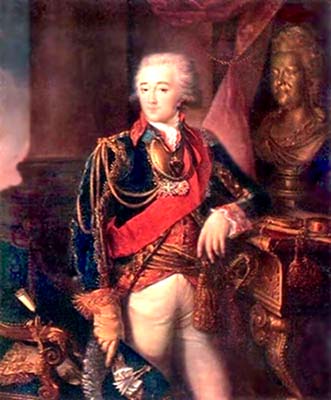
|
Ì.².Àrgunov.
The Count A.M.Dmitriyev-Mamonov.
|
Emperor Joseph II continued informing about his first minutes of the meeting with Catherine II. He wrote to his Field-Marshal Lassi: "Yesterday it became so cold that we had to put on our fur-coats, and in the evening Her Majesty gave orders to light the fire in the fire-place... The galleys in which Catherine's suite have been accomodated are beautiful, very comfortable but a little too large and heavy. There are too many shallow places in the Dnieper and that's why the river is inconvenient for large vessels. The troops have been dressed in new uniforms. Potemkin is doing everything that he plans, his standing at court is better than ever and his power is unlimited. The new favourite (Dmitriyev-Mamonov) is still quite a child, about 26 years old, having no education, not far in his mind, quite handsome, it seems that he himself does not believe in his fortune. The Empress herself has become thinner a little and, by the way, is m perfect health."
Emperor Joseph II has praised very highly all of the Prince's orders to his face and had even paid his attention to Potemkin, but in his letters to his closest friends and relatives Joseph II denounced all that he had seen finding neither order nor anything interesting. Particularly he condemned Prince Potemkin for not paying attention to the officers of lower rank.
In New Kodak everything had been prepared beforehand ready to receive the eminent travellers. On the bank of the Dnieper on the vessels erected was a triumphal arch decorated with garlands of all kinds of live flowers and golden ears of grain forming the words: "To Thee from Thy Own." Separately constructed was a beautiful wooden palace which later on was turned into a local cloth factory.
When the travellers came near the village of New Kodak a cannonade burst out and the church bell's chiming began. The guests were met by the Yekaterinoslav Archbishop Amvrosius Serebrennikov near St. Nicholas's church and at the palace entrance stood the Governor-General His Highness Prince Potemkin himself with bread and salt as the host of the region.
While waiting for the arrival of all the vessels, some of which had run aground, Catherine II stayed 2 days in New Kodak (May 7 and 8). In the mornings Archbishop Amvrosius came to the palace with some eminent citizens, officials and military men of Yekaterinoslav. The eminent citizens brought the Empress bread and salt on glazed earthenware dishes and local fruits. The Empress extended her hand to all present.
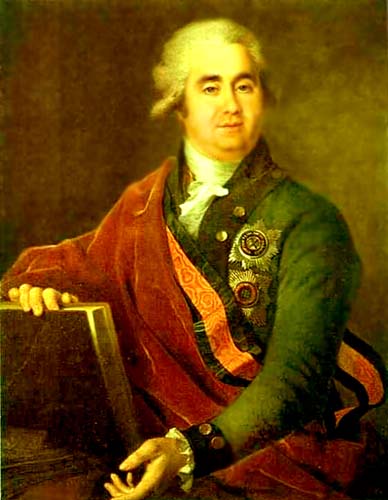
|
D.G.Levitsky.
The Count Bezborodko.
|
By the evening of May 8 all the belated vessels drew up to the New Kodak pier and after inspection it was found that none of them needed any repairing. But it was necessary to be able to pass further through 9 large rapids and the most terrible among them was Nenasytets (the Insatiable).
By Catherine's order Prince Potemkin called the best pilots from Kodak and Kamenka and asked them whether all of the vessels of the Empress would be able to pass safely through the Dnieper rapids and go on further to Kherson. The pilots asked permission to examine all the vessels in detail. Then the pilots said that the vessels could pass only in case if the rudders were taken off and replaced with "stemos" (long, thick and wide boards, each cut out of a trunk of a tree to look like shovels). The boats, steered by 10-12 helmsmen standing opposite one another and turning the stemos from one side to another, are manoeuvred further on among the rocks down the river from New Kodak at great speed.
Permission was-given for such a change and then in the morning of May 9 all the vessels started down the Dnieper, but the Empress and her retinue on the same day (on the day of St. Nicholas) at 9 a.m. started by land from New Kodak to the village of Polovitsa to lay the foundation for the cathedral.
The Empress drove in the six-seater carriage with the Austrian Emperor Joseph II, Countess Branitskaya, Prince Potemkin, Count Kobenzel and Dmitriyev-Mamonov.
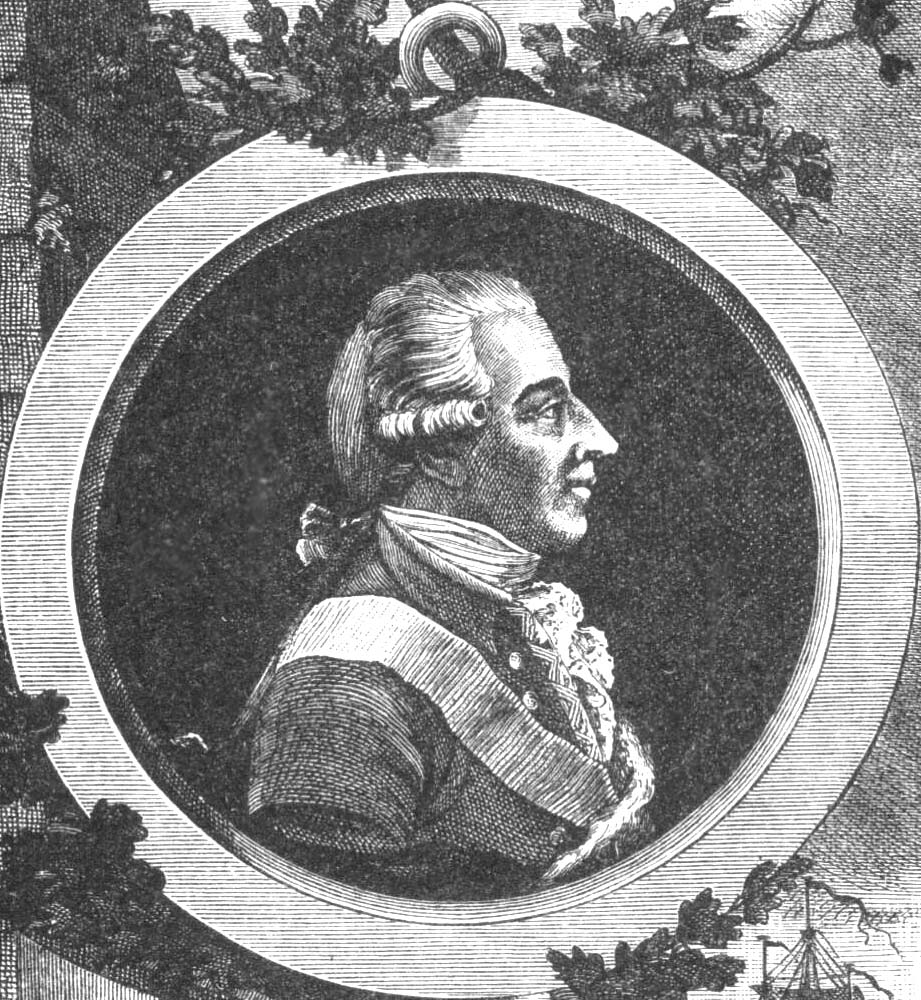
|
The Prince Nassau.
|
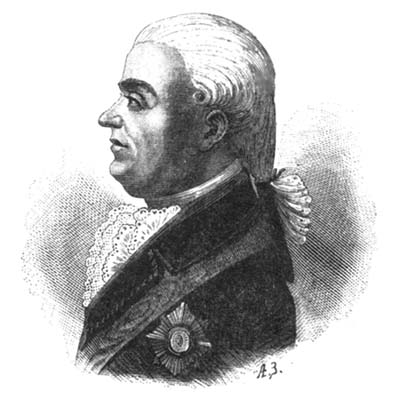
|
The Count Kobenzel.
|
The settlement of Polovitsa was situated lower down stretching along the rivulet Polovitsa. To the east of the Polovitsa village there rose a high, open, uninhabited hill from which there was a distant beautiful view of the steppe covered in this season with thick bright-green grass and sprinkled with a multitude of flowers of various kinds.
Having climbed upon the hill and surveyed all around the Empress said: "This place looks like a pleasant abode."
This is where the city shall be! Here shall the Cathedral of the Transfiguration of our Lord stand! The site for the cathedral had already been chosen by Faleyev. Mikhail Leon-tyevich Faleyev, the supervisor of the work, a former simple merchant of Kryukov, then a colonel, Prince Potemkin's favourite, and General Sinelnikov's right hand had also erected light elegant pavilions near the future cathedral beforehand in which the Empress and her splendid suite were supposed to be treated with a fine dinner.
Apart from the built pavilions a camp tent was set up for the Empress with a mobile military church.
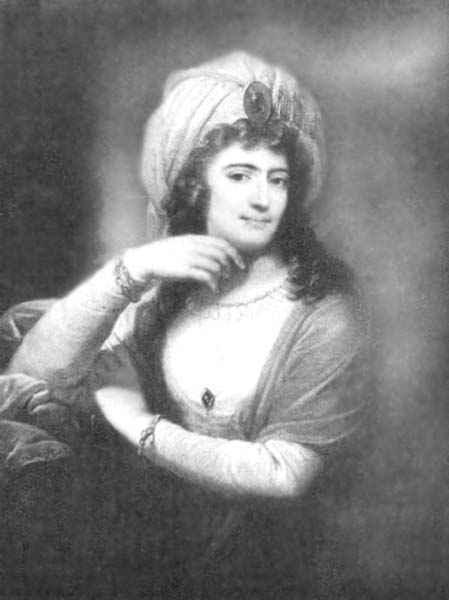
|
J.Grassi.
The Countess Branitskaya.
|
"Eight versts away from Kodak," writes the first historian of the Novorossiisk territory Archbishop Gavriil Rozanov, "on the elevated bank of the Dnieper, from which one could see the curves of the river and islands covered with forests, and on the place buried in verdure and flowers, where the sacred Lord's Cathedral was to be erected, the Empress's camp tent was set up with a mobile field regiment's church. Right Reverend Amvrosius (Archbishop of Yekaterinoslav and Tauric Chersonese) met Her Majesty with a cross and holy water and performed a service of Divine Liturgy in the church in the presence of the Empress. During the service there was nobody else except the choristers and 12 maids of honour who accompanied her. Joseph II only looked into the church and immediately went with His Highness and other generals to the very place where the ground was being cleared for the foundation of the cathedral...
When the Mass ended Right Reverend Amvrosius brought up the cross to the Empress; she kissed it and bowed towards both sides and went to the site of the future cathedral accompanied by His Highness. The site of the future cathedral was marked only to show the sizes: on the place where the foundation was to be laid only grooves had been made and the land were smoothed out. According to the witness Nikita Leontyevich Korzh, this was done because of the suddenness and hurry they had not managed to dig out the foundation and would begin digging the trenches only after the tsarina had passed by.
In the place where the communion-table (altar) was to stand a large ditch looking like a vault or a cave had been dug out, the depth of it was almost a sagene, the width more than 2 sagenes, the descent into the vault (a gangway) was built and covered with a carpet like the whole vault itself.
Then the ceremony began, the case for that was presentable: the council of bishops with all the clergy and the whole procession which first had come from the south, then turned to the east and with a cross and banners passed over the cleared-up place to the site where the altar would stand. And Right Reverend Amvrosius walking with a cross sprinkled holy water on both sides. After reaching the vault everybody stopped, Then the Empress with Joseph II and His Highness Prince Potemkin began "ceremoniously" to descend the steps to the bottom of the vault and they were followed by some of the noble personages. There they listened to the "church doxology performed according to the ecclesiastic ceremonial." After that Right Reverend Amvrosius offered up a prayer and sprinkled the vault with holy water. Then the Empress, having crossed herself and bowed on both sides to the people,
placed the first stone in the foundation of the cathedral and added to that 8 different coins, the sum of which was 67 roubles. They were: an imperial (a gold coin of the former Russian Empire.- Transl.) of 1756 and a gold half imperial of 1785; silver - a rouble of 1780; 25 copecks of 1765; 29 copecks of 1785; 15 copecks of 1781; 10 copecks of 1769; 5 copecks of 1745. Lacking was one 5-copeck coin, then (as a legend tells us) Catherine asked: "Has anyone got a 5-copeck coin?" One of those present handed the lacking coin to General Sinelnikov for him to pass it over to the tsarina. All of that was covered with a gilded copper plate engraved with the following words: "Catherine II, the Empress of all Russia, laid the first stone into the foundation of the Cathedral of the Transfiguration of Our Saviour in 1787." The plate was passed to Catherine by Prince Potemkin.
The second stone was laid by Emperor Joseph II. "Empress Catherine II and I have performed a great deed on one and the same day: into the foundation of the cathedral she placed the first stone and I the second'-and the last." And his prophecy to his retinue after the ceremony (as it was proved in the future) became quite true.
The French ambassador Count Segur from his point of view said that there would hardly ever be a divine service in that cathedral, the foundation of which had just been laid.
The third stone was laid by Prince Potemkin, the fourth by Archbishop Amvrosius and the fifth by General I. M. Sineini' kov. After all these stones had been placed in the foundation, the Ecclesiastical Senate proclaimed a prayer for the prolongation of days to the great name and under the cannonade and chiming church bells the "hurrah!" of all the people spread in the surrounding uninhabited country. The banks of the Borysthenes shook from the joyful cries.
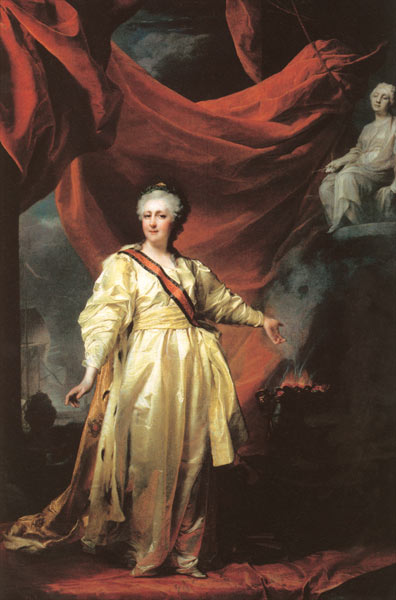
|
D.G.Levitsky.
The Empress Catherine II.
|
That is how the ceremony ended, the site was sanctified and the foundation of the cathedral of 12 altars laid. According to the Archbishop Gavriil's calculation, "the size of the cathedral was to be 71 sagenes in length, 21 sagenes plus one arshin (1 arshin=28 inches.- Transl.) in width. Therefore, the sanctuary in Yekaterinoslav was planned to be the greatest in the world in size with which probably only the St. Peter Cathedral in Rome could be equal in space measurement."
And in order that the church of St. Peter in Rome should not be equal in size with the Transfiguration Cathedral in Yekaterinoslav Prince Potemkin when laying the foundation said to the architect: "Add one more little arshin!" So the architect (according to folklore) did it. It seems that Archbishop Gavriil knew about that addition, in his notes written were "71 sagenes and 21 sagenes plus 1 arshin."
"At the same time and on the same day and hour," wrote Gavriil, "from the lips of the Empress herself this town got its name Yekaterinoslav..." The inhabitants, who had been living in Polovitsa up to that date, were announced free to move to different places. According to the order that they were free to choose and had the right to settle down where they wished. Some of them, the largest part, moved to live in the settlement of Sukhachoyka, a smaller part to Mandrykovka in which there had been only one Cos5ack wintering there and being occupied in fishing on the Dnieper. Having settled beside him the people called their new settlement Mandrykovka after the Cossack's name Mandryka.
"The titled citizens of the new town cherished a hope that . after the ceremony of laying the foundation of the cathedral the Empress would make them happy by being present and sharing their feast. But in vain, the dinner for the important personages had already been ordered to be at the first stop after leaving Yekaterinoslav.
When Catherine was leaving Yekaterinoslav she was presented with a product of the local silk stocking factory - a pair of wonderful silk stockings so thin as if made of a web and could be put in a nut shell. However, there had already passed rumours that His Highness had sent a courier to Paris for such stockings long before this event took place."
Under the thunder of cannons, the crackle of gun-fire and excited shouting of the people Empress Catherine II and all her numerous suite left Yekaterinoslav on the very same day.
Meanwhile, those who had remained at the foot of the church foundation, by having beheld the tsarina with their own eyes and also the ceremony with the most famous clergy, the gentry, the merchants and, in general, all of the people were being treated by Lieutenant-Colonel M. L. Fa-leyev (who was His Highness's confidential person). It was said that the festival had been so unusual. For each one not only imagined but was sure that Yekaterinoslav would become the centre of both power and wealth, of people's enlightment on the whole southern territory, that it would become the second Rome, the new Athens. The genius of Prince Potemkin pledged that the above-mentioned event would undoubtedly come true." |
|
|